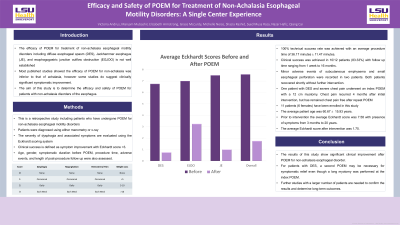Sunday Poster Session
Category: Interventional Endoscopy
P0851 - Efficacy and Safety of POEM for Treatment of Non-Achalasia Esophageal Motility Disorders: A Single Center Experience
Sunday, October 22, 2023
3:30 PM - 7:00 PM PT
Location: Exhibit Hall

Has Audio

Victoria Andrus, MD
Louisiana State University Health Sciences Center
Shreveport, LA
Presenting Author(s)
Victoria Andrus, MD1, Maryam Mubashir, MD2, Elizabeth Armstrong, BA2, Grace McCurdy, 2, Michelle Neice, MD2, Shazia Rashid, MD2, Syed Musa Raza, MD2, Nazar Hafiz, MD2, Qiang Cai, MD, PhD, MACG2
1Louisiana State University Health Sciences Center, Shreveport, LA; 2LSU Health Sciences Center, Shreveport, LA
Introduction: The efficacy of peroral endoscopic myotomy for treatment of non-achalasia esophageal motility disorders including diffuse esophageal spasm (DES), Jackhammer esophagus (JE), and esophagogastric junction outflow obstruction (EGJOO) is not well established. Most published studies showed the efficacy of POEM for non-achalasia was inferior to that of achalasia, however some studies suggest clinically significant improvement. The aim of this study is to determine the efficacy and safety of POEM for patients with non-achalasia disorders of the esophagus.
Methods: This is a retrospective study including patients who have undergone POEM for non-achalasia esophageal motility disorders diagnosed with either manometry or x-ray from 2021 to 2022 at LSU Health Shreveport Ochsner Hospital. The severity of patients’ dysphagia and associated symptoms before and after intervention are evaluated using the Eckhardt scoring system. Clinical success is defined as symptom improvement with Eckhardt score < 3. Age, gender, symptomatic duration before POEM, procedure time, adverse events, and length of post-procedure follow up were also assessed.
Results: A total of 11 patients (6 females) have been enrolled in this study following POEM for treatment of DES, JE, EGJOO. The average patient age was 60.67 ± 15.93 years. Prior to intervention the average Eckhardt score was 7.58 with presence of symptoms from 3 months to 20 years. A 100% technical success rate was achieved with an average procedure time of 36.17 minutes ± 11.47 minutes. Minor adverse events of subcutaneous emphysema and small esophageal perforation were recorded in two patients. Both patients recovered shortly without further intervention. Clinical success was achieved in 10/12 patients (83.33%) with follow up time ranging from 1 week to 16 months. The average Eckhardt score after intervention was 1.75. One patient with DES and severe chest pain underwent an index POEM with a 12 cm myotomy. Chest pain recurred 4 months after initial intervention. A repeat POEM was performed and the patient has remained chest pain free for 14 months.
Discussion: The results of this study show significant clinical improvement after POEM for non-achalasia esophageal disorders. There were no major adverse events. For patients with DES, a second POEM may be necessary for symptomatic relief even though a long myotomy was performed at the index POEM. Further studies with a larger number of patients are needed to confirm the results and determine long-term outcomes.
Disclosures:
Victoria Andrus, MD1, Maryam Mubashir, MD2, Elizabeth Armstrong, BA2, Grace McCurdy, 2, Michelle Neice, MD2, Shazia Rashid, MD2, Syed Musa Raza, MD2, Nazar Hafiz, MD2, Qiang Cai, MD, PhD, MACG2. P0851 - Efficacy and Safety of POEM for Treatment of Non-Achalasia Esophageal Motility Disorders: A Single Center Experience, ACG 2023 Annual Scientific Meeting Abstracts. Vancouver, BC, Canada: American College of Gastroenterology.
1Louisiana State University Health Sciences Center, Shreveport, LA; 2LSU Health Sciences Center, Shreveport, LA
Introduction: The efficacy of peroral endoscopic myotomy for treatment of non-achalasia esophageal motility disorders including diffuse esophageal spasm (DES), Jackhammer esophagus (JE), and esophagogastric junction outflow obstruction (EGJOO) is not well established. Most published studies showed the efficacy of POEM for non-achalasia was inferior to that of achalasia, however some studies suggest clinically significant improvement. The aim of this study is to determine the efficacy and safety of POEM for patients with non-achalasia disorders of the esophagus.
Methods: This is a retrospective study including patients who have undergone POEM for non-achalasia esophageal motility disorders diagnosed with either manometry or x-ray from 2021 to 2022 at LSU Health Shreveport Ochsner Hospital. The severity of patients’ dysphagia and associated symptoms before and after intervention are evaluated using the Eckhardt scoring system. Clinical success is defined as symptom improvement with Eckhardt score < 3. Age, gender, symptomatic duration before POEM, procedure time, adverse events, and length of post-procedure follow up were also assessed.
Results: A total of 11 patients (6 females) have been enrolled in this study following POEM for treatment of DES, JE, EGJOO. The average patient age was 60.67 ± 15.93 years. Prior to intervention the average Eckhardt score was 7.58 with presence of symptoms from 3 months to 20 years. A 100% technical success rate was achieved with an average procedure time of 36.17 minutes ± 11.47 minutes. Minor adverse events of subcutaneous emphysema and small esophageal perforation were recorded in two patients. Both patients recovered shortly without further intervention. Clinical success was achieved in 10/12 patients (83.33%) with follow up time ranging from 1 week to 16 months. The average Eckhardt score after intervention was 1.75. One patient with DES and severe chest pain underwent an index POEM with a 12 cm myotomy. Chest pain recurred 4 months after initial intervention. A repeat POEM was performed and the patient has remained chest pain free for 14 months.
Discussion: The results of this study show significant clinical improvement after POEM for non-achalasia esophageal disorders. There were no major adverse events. For patients with DES, a second POEM may be necessary for symptomatic relief even though a long myotomy was performed at the index POEM. Further studies with a larger number of patients are needed to confirm the results and determine long-term outcomes.
Disclosures:
Victoria Andrus indicated no relevant financial relationships.
Maryam Mubashir indicated no relevant financial relationships.
Elizabeth Armstrong indicated no relevant financial relationships.
Grace McCurdy indicated no relevant financial relationships.
Michelle Neice indicated no relevant financial relationships.
Shazia Rashid indicated no relevant financial relationships.
Syed Musa Raza indicated no relevant financial relationships.
Nazar Hafiz indicated no relevant financial relationships.
Qiang Cai indicated no relevant financial relationships.
Victoria Andrus, MD1, Maryam Mubashir, MD2, Elizabeth Armstrong, BA2, Grace McCurdy, 2, Michelle Neice, MD2, Shazia Rashid, MD2, Syed Musa Raza, MD2, Nazar Hafiz, MD2, Qiang Cai, MD, PhD, MACG2. P0851 - Efficacy and Safety of POEM for Treatment of Non-Achalasia Esophageal Motility Disorders: A Single Center Experience, ACG 2023 Annual Scientific Meeting Abstracts. Vancouver, BC, Canada: American College of Gastroenterology.
